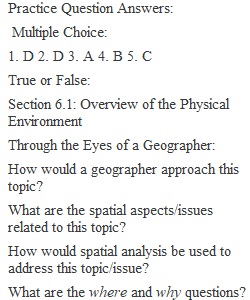


Q Section 6.1: Overview of the Physical Environment Through the Eyes of a Geographer: How would a geographer approach this topic? What are the spatial aspects/issues related to this topic? How would spatial analysis be used to address this topic/issue? What are the where and why questions? How can this topic be studied and analyzed using the five themes of geography? Overview: No physical feature or human activity is distributed evenly on the earth’s surface. Geographers study the spatial variation of all components of the physical environment, looking for patterns and their underlying processes. As always, geographers want to know and understand where something is and why it is there. The earth is always undergoing change. Some of the key physical processes that shape the earth are plate tectonics, erosion, glaciation, and climate. In addition to these natural processes, human activities dramatically alter and destroy the physical environment, continually bringing change to the earth. Climate change is a dramatic example of human environment interaction – one that puts all life on planet earth at risk. Critical Thinking/Discussion Questions: 1. Why is it important to learn about the physical environment? How often do you think about the physical environment and the way that humans use it? Discuss the role of values and beliefs in shaping human environment interaction? 2. What is the “Ring of Fire”? Discuss impacts of this “ring” on human settlement patterns. 3. On a global scale, where do humans tend to settle with regard to the physical environment? How do humans shape the environment? How does the environment shape humans? Practice Questions (Write Correct Answer in Blank): Multiple Choice: 1. ___ The name of the “super-continent” that was centered around the present-day African continent: A) megalopolis B) Mesopotamia C) cenozoic D) pangea 2. ___ His ideas were originally rejected, but now he is known as “the father of continental drift”: A) Sauer B) Mercator C) Christopherson D) Wegener 3. ___ The most seismically active portion of the earth’s surface (commonly referred to as The Ring of Fire): A) Pacific Rim B) San Andreas Fault C) Yucatan Peninsula D) Himalayan Mountain Region 4. ___ On a global scale, earthquakes and volcanoes are typically associated with: A) cold climates B) plate boundaries C) europhication D) population clusters 5. ___ When two tectonic plates collide and one dives beneath the other, it is called a : A) stromboian eruption B) inversion fault C) subduction zone D) surficial rupture True or False: 1. ___ Most scientists agree that the earth is at least 4.6 billion years old. 2. ___ Typically, earthquakes do not kill people, buildings do. 3. ___ The physical environment remains constant and does not often change. 4. ___ The geologic time scale is a summary time line of all earth history. 5. ___ A region is an area that has a common characteristic that distinguishes it from its surroundings.
View Related Questions